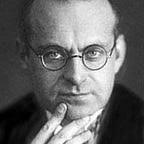From Geometry to Philosophy: The Mathematical Roots of Postmodernism
Postmodernism, contrary to the popular imagination, is not merely an ephemeral Stimmung of contemporary society. Neither is it the latest development in art or architecture, nor the malaise experienced after the failure of modernism. Least of all is it the result of the arrogance or extremism of certain academics.
Of course, it is all of these things too. But on a more fundamental level, which allows us to understand it not merely as a passing trend, postmodernism is the outgrowth of certain mathematico-logical discoveries made in the early 20th century.
In particular, Henri Poincaré’s investigations into non-Euclidean geometry began a deconstructive process which reached its apogée, in the world of mathematics and logic at least, with Gödel’s incompleteness theorems. Upon recognizing Eugenio Beltrami’s proof that non-Euclidean geometry is consistent in the same way as Euclidean geometry, Poincaré concluded that these two systems of geometry were both “true” (or rather produced true statements), but only with respect to their foundational axioms (non-Euclidean geometry of course lacking Euclid’s fifth axiom). In other words, although a certain result of non-Euclidean geometry could contradict a result of Euclidean geometry, each result is still “true” insofar as the truth of each is determined by their respective axioms.
To provide an example, anyone with a cursory knowledge of mathematics knows that (in Euclidean geometry) the internal angles of a triangle necessarily add up to 180 degrees. However, in non-Euclidean geometry, because it drops the parallel postulate and thus allows for curved planes, this sum becomes variable. Although these two conclusions contradict each other, both the Euclidean and non-Euclidean results are “true” — but only by virtue of their respective axioms.
Of course, one could argue that one of these axiomatic systems, as such, is more correct than the other. But how would one go about determining the superiority of one over any other? One would have to construct a new (axiomatic) system or methodology of determining the superiority, correctness, or truth of axiomatic systems (or even of axioms themselves): a metalanguage. But the problem with this approach should be obvious: we could construct a variety of these metalanguages (just as we can create numerous geometries), thus entailing the need for a third-order language to determine which metalanguage or second-order language is the best. This leads to an infinite regress.
Axioms and their syntheses are thus not a priori. So even at the level of logic and mathematics, absolute (necessary) truth as such doesn’t exist: there is always a level of contingency, and the zero grade of all logical contingency is the contingency of one’s (choice of) axioms. This line of thought does not, however, necessitate a radical subjectivism: “objective” truth still exists, but the standard of this objectivity is rooted in foundational definitions, assumptions, and contingencies. In other words, two Euclidean geometrists are still able to agree that the sum of the internal angles of a triangle is 180 degrees (they can agree that this statement is “objectively true,” that this statement is not subjective) while also acknowledging that the objective truth of this statement is contingent upon the particular geometric framework in which they happen to be working. In a strange twist, it is precisely contingency which grounds the necessity of particular conclusions. Hence we are dealing with a relative objectivity (mathematics is neither absolute nor subjective).
But if objectivity is itself relative on the level of logic and math, as a pure formalism, then we have very little hope for an absolute objectivity on the level of empirical science, culture, ethics, politics, etc. Each is much more complex of an undertaking, and riddled with many more layers of contingency, when compared with mathematics. And so while postmodernism certainly has its realization as an architecture, as a fashion, as an art, as a politics, as a social relation, these phenomena cannot be considered mere trends or choices or styles or moods — they emerge unavoidably from a fundamental (non-)discovery on the level of pure logic.
Thus, the core idea of postmodernism is that there is no absolute ground for knowing, for morality, for meaning, for politics, for a telos or an end of human history: the ground itself is relative, and we would fall right through it if not for its relative objectivity. If there is a telos of science (in the sense of the Latin scientia or the German Wissenschaft), it is this very deconstruction of itself: the end of science is the discovery of the impossibility of an absolute science (this is also why the physicist’s dream of a “theory of everything” is a delusional fantasy). In the same way, the end of history is comprised of the realization that it is impossible for history to end (utopia is reached at the moment when we stop trying to achieve utopia; or, from a different angle, the end of history is ou-topian, a non-place, rather than eu-topian, a good-place).
The fundamental question of postmodernism is how to act in a world in which there is no absolute ground for action. What is “good” (let alone the highest good) in a universe in which there is no absolute ground for morality? What is beautiful in an aesthetics which rejects absolute beauty? What is knowledge for a philosophy which gives up on “absolute knowing?” Paralysis, here, would mean defeat and cowardice. In a postmodern world, we must grapple with and eventually embrace our condition of relative objectivity. After all, there is no moving “beyond postmodernism”: one must instead learn to move within its beyond.
